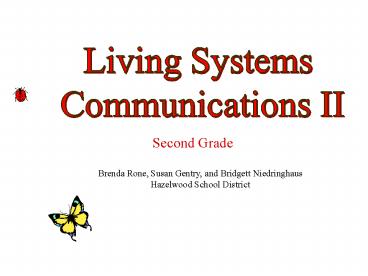Living Systems PowerPoint PPT Presentation
1 / 10
Title: Living Systems
1
Living Systems Communications II
Second Grade
Brenda Rone, Susan Gentry, and Bridgett
Niedringhaus Hazelwood School District
2
- Teacher Page
- Second Grade, Show Me Standard CA 1 and 3
- The elements of Living Systems and communication
skills are integrated in the activities. - We suggest that students keep a journal.
- It is critical for students to use writing skills
to explain answers. When you see this
symbol students should use their journals. - Please take time to discuss possible answers.
Click to go to each new screen.
3
Non-fiction Activity
4
Reptiles
Vertebrate- an animal with a backbone.
Cold-blooded- body temperature is same as the
air around them.
Reptiles belong to a group of animals
called vertebrates. They are cold-blooded and
breathe through their lungs. Most reptiles hatch
from eggs, and while the young look much like
their parents, they may be colored differently.
Most reptiles are meat-eaters and feed on the
prey in their environment.
Prey- the creatures another animal hunts and eats.
5
The tortoise is one member of the reptile
family. It lives entirely on land, has scaly
skin, and a hard shell to cover its body. Unlike
most reptiles, the tortoise eats grass, fruit,
and plants. Some tortoises have been known to
live up to 100 years and weigh over 500 pounds.
The turtle also belongs to the family of
reptiles. Most turtles have hard shells, but
some water turtles have soft shell. All turtles
have scaly skin. Turtles can live both on land
or in water. Turtles feed on earthworms, snails,
insects, fish, or anything it can catch.
6
Questions
1. Give an example of how the shell of a tortoise
or turtle could help them in times of danger. 2.
Are you cold-blooded? Explain 3. Are you a
vertebrate? Explain
Answers next
7
Answers
1. In times of danger the turtle and tortoise can
pull their bodies inside the shell to protect it
from predators, such as a fox or coyote.
2. Humans are not cold-blooded. Their body
temperatures stay the same. We sweat when we are
hot and shiver when we are cold. To adjust to
our environment we change types of clothing and
shelters. For example, in the winter we use heat
in our homes and we wear coats and gloves. In
the summer, we use air-conditioning to cool our
homes and we wear shorts or light weight clothing.
Answers continued.
8
3. Humans are vertebrates. We have a backbone,
or spine. The backbone allows us to bend and
twist.
9
Complete the following Venn Diagram
using information from the story.
to story
turtle
tortoise
live on land or in water
live only on land
cold- blooded
answers
10
Venn Diagram
turtle
tortoise
live on land or in water
live only on land
shell
cold- blooded
vertebrate
soft or hard shell
hard shell
scaly skin
plant-eater
reptile
meat-eater
End of Activity

